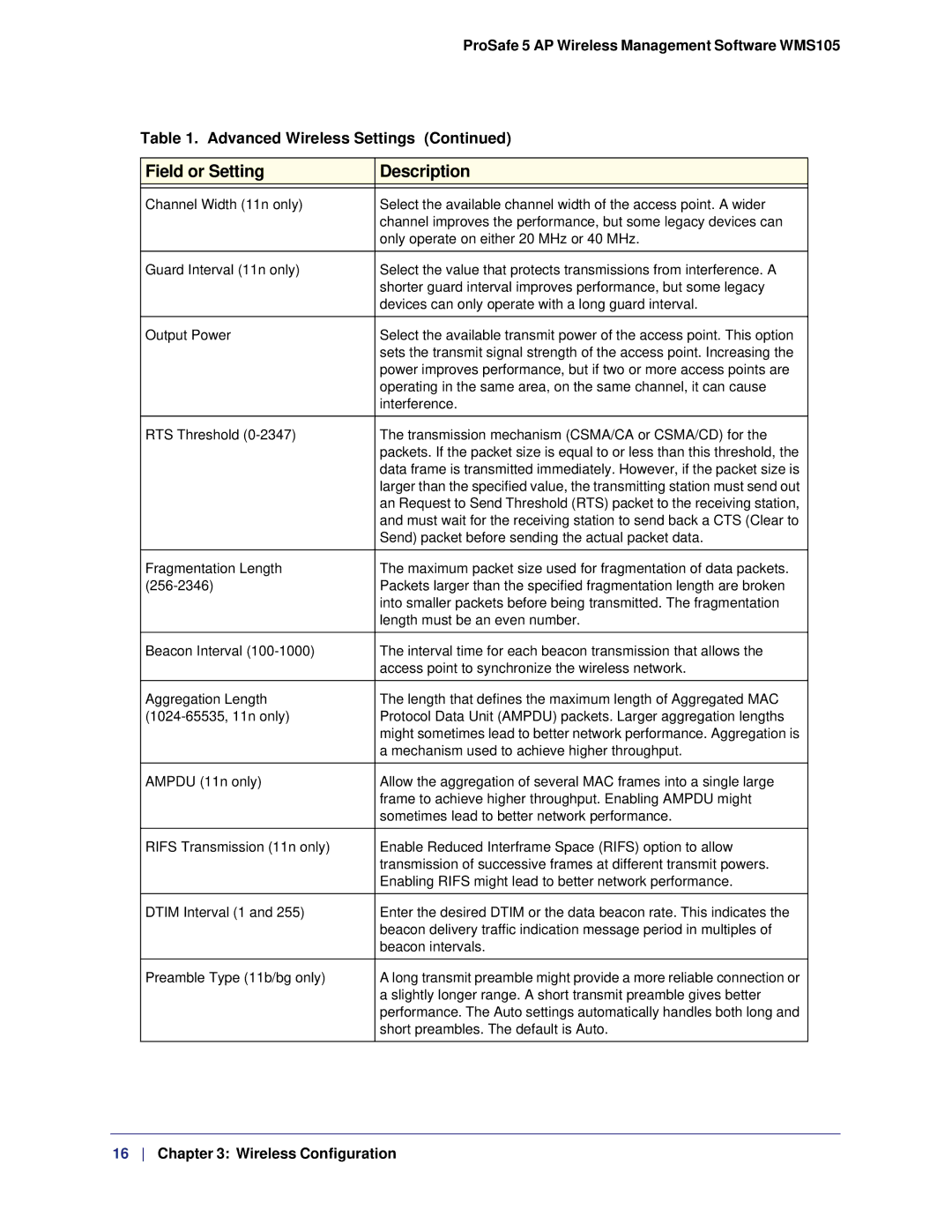
ProSafe 5 AP Wireless Management Software WMS105
Table 1. Advanced Wireless Settings (Continued)
Field or Setting | Description |
|
|
Channel Width (11n only) | Select the available channel width of the access point. A wider |
| channel improves the performance, but some legacy devices can |
| only operate on either 20 MHz or 40 MHz. |
|
|
Guard Interval (11n only) | Select the value that protects transmissions from interference. A |
| shorter guard interval improves performance, but some legacy |
| devices can only operate with a long guard interval. |
|
|
Output Power | Select the available transmit power of the access point. This option |
| sets the transmit signal strength of the access point. Increasing the |
| power improves performance, but if two or more access points are |
| operating in the same area, on the same channel, it can cause |
| interference. |
|
|
RTS Threshold | The transmission mechanism (CSMA/CA or CSMA/CD) for the |
| packets. If the packet size is equal to or less than this threshold, the |
| data frame is transmitted immediately. However, if the packet size is |
| larger than the specified value, the transmitting station must send out |
| an Request to Send Threshold (RTS) packet to the receiving station, |
| and must wait for the receiving station to send back a CTS (Clear to |
| Send) packet before sending the actual packet data. |
|
|
Fragmentation Length | The maximum packet size used for fragmentation of data packets. |
Packets larger than the specified fragmentation length are broken | |
| into smaller packets before being transmitted. The fragmentation |
| length must be an even number. |
|
|
Beacon Interval | The interval time for each beacon transmission that allows the |
| access point to synchronize the wireless network. |
|
|
Aggregation Length | The length that defines the maximum length of Aggregated MAC |
Protocol Data Unit (AMPDU) packets. Larger aggregation lengths | |
| might sometimes lead to better network performance. Aggregation is |
| a mechanism used to achieve higher throughput. |
|
|
AMPDU (11n only) | Allow the aggregation of several MAC frames into a single large |
| frame to achieve higher throughput. Enabling AMPDU might |
| sometimes lead to better network performance. |
|
|
RIFS Transmission (11n only) | Enable Reduced Interframe Space (RIFS) option to allow |
| transmission of successive frames at different transmit powers. |
| Enabling RIFS might lead to better network performance. |
|
|
DTIM Interval (1 and 255) | Enter the desired DTIM or the data beacon rate. This indicates the |
| beacon delivery traffic indication message period in multiples of |
| beacon intervals. |
|
|
Preamble Type (11b/bg only) | A long transmit preamble might provide a more reliable connection or |
| a slightly longer range. A short transmit preamble gives better |
| performance. The Auto settings automatically handles both long and |
| short preambles. The default is Auto. |
|
|
16 Chapter 3: Wireless Configuration
